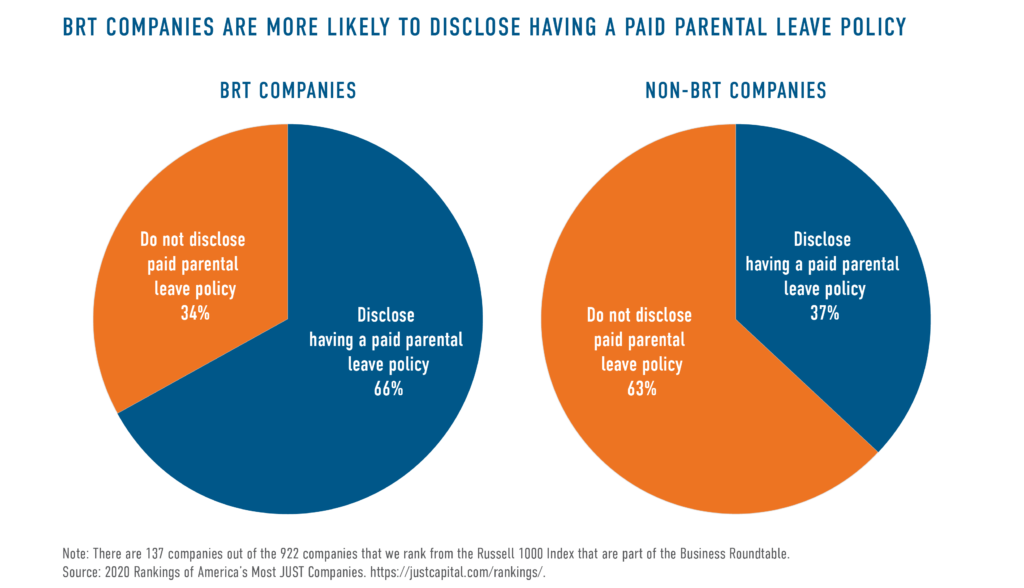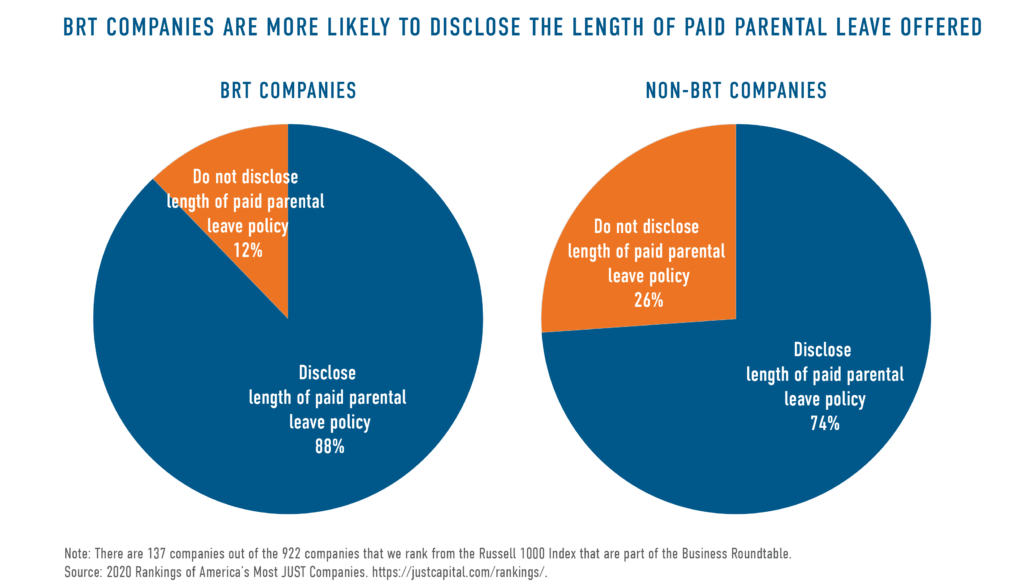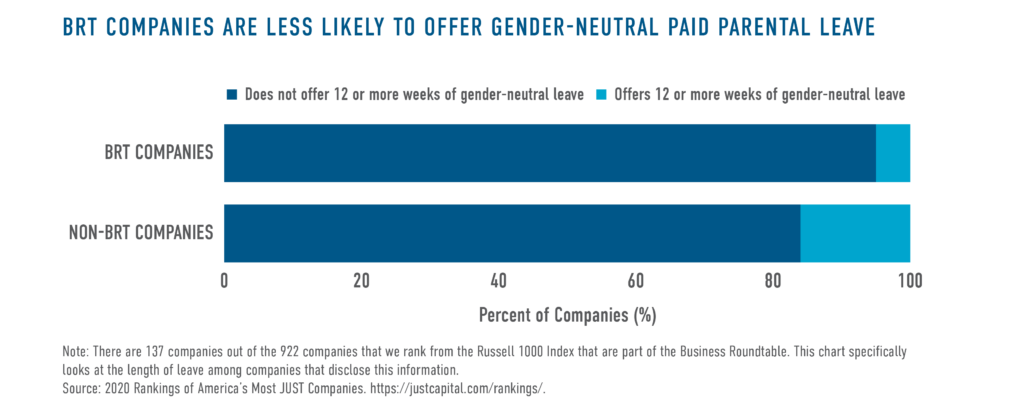The Business Roundtable Advocates for Paid Parental Leave: Here’s How Members Fare
To this day, the United States remains the only country among its economically advanced peers without a legislated paid parental leave policy, which provides parents paid time off around childbirth or adoption. And as a consequence, only 18% of private-sector workers have access to paid family leave. Recognizing that paid parental leave is critical for the physical, social, and economic health of families, a patchwork of state policy has emerged to fill the gaps.
States aren’t the only ones that have stepped up, though. Increasingly, companies have established their own paid parental leave policies, supported by a wealth of research that shows that these policies are good for business, too. Through these efforts, 29% of workers at large firms in the private sector receive paid family leave benefits. But there’s still a long way to go.
Which is why we applaud the Business Roundtable’s letter to Congress last Thursday, on behalf of member CEOs serving more than 15 million employees, urging lawmakers to make paid family leave available to “as many working Americans as possible.” The letter was penned by Ginni Rometty, CEO of IBM and Chair of the Education and Workforce Committee on Business Roundtable, and comes as Congress is set to provide all federal workers with 12 weeks of paid parental leave. Our question is always: What do the data show? Do Business Roundtable companies live up to their verbal commitment when it comes to paid parental leave? According to data used in our 2020 Rankings of America’s Most JUST Companies, it turns out BRT companies are more likely to offer paid parental leave, although they provide fewer weeks of leave compared to non-BRT companies.
BRT companies are more likely to disclose having a paid parental leave than their non-BRT peers.
Across the 922 large-cap companies we rank, 378 companies, or 41%, disclose having a paid parental leave policy. Among the 137 Business Roundtable companies we rank, however, this share is much higher. We found that 66% of Business Roundtable (BRT) companies disclose having paid parental leave while just 37% of non-BRT companies disclose the same. In other words, BRT companies are nearly two times more likely than their non-BRT peers to disclose offering paid parental leave to their employees.

BRT Companies have better disclosure around the details of paid parental leave policies.
Yet just having a paid parental leave policy isn’t sufficient. Research also shows that the length of paid parental leave is just as important. Fewer companies disclose this information. Of the 378 companies that we note have paid parental leave policies, 77% share the number of weeks of leave available to new parents, whether new mothers, fathers, primary or secondary caregivers, or adoptive parents.
Among BRT companies that have a paid parental leave policy, 88% disclose details about the length of leave, while 74% of non-BRT companies with a policy disclose the same.

BRT companies don’t offer as much time off for paid parental leave as their non-BRT peers.
This detailed disclosure allows us to further unpack exactly how many weeks of paid parental leave companies offer. Overall, companies give about 12 weeks of paid leave to mothers and roughly seven weeks of paid leave to fathers. BRT companies perform slightly less well, on average, offering about 11 weeks of maternity leave and six weeks of paternity leave.
Taking a closer look, we find that, of the BRT companies that disclose the length of paid leave for new mothers, 18% offer under six weeks of leave, 32% offer six to 12 weeks, and 50% offer 12 or more weeks. Of the BRT companies that disclose the length of paid leave for new fathers, roughly 57% offer under six weeks, 32% offer six to 12 weeks, and 11% – just eight companies – offer 12 or more weeks of leave. A higher proportion of non-BRT companies offer longer leave for both mothers and fathers: For instance, 59% and 22% of non-BRT companies that disclose the length of maternity and paternity leave, respectively, provide their employees with 12 or more weeks.

Due to much lower levels of disclosure, we were unable to analyze details about paid parental leave among adoptive parents, and parents of all gender identities. While this is a limitation of this research, it signals that paid parental leave policies could benefit by being more inclusive and using more inclusive language. Rather than “mother” and “father,” the language some companies might utilize would be “primary and secondary caregiver.” Some companies have adopted this language already, but gendered parental categories remain the norm.
BRT companies have room to improve when it comes to developing and disclosing gender-neutral paid parental leave.
Implicit in the findings about length of leave – and concerns about the inclusivity of paid parental leave policies – few policies offer equal time for mothers and fathers to bond with their new children despite the fact that research shows gender-neutral paid parental leave helps curb persistent gender inequality. This problem is not endemic to BRT companies, though they show considerably more room for improvement compared to their peers.
Among BRT companies that disclose the length of their paid parental leave programs, 5% – or four companies – provide 12 or more weeks of paid leave given to both mothers and fathers. 16% of non-BRT companies have 12 or more weeks of gender-neutral leave.

The first step in this shift toward gender-neutral paid parental leave is of course the establishment of policies that are inclusive of parents of any gender. But a deeper shift must also take place in and around corporate culture, where men often feel unable to take leave even when they have it. Still, fathers are also fighting for this kind of leave – JPMorgan Chase, a BRT member, settled a lawsuit this year extending paid leave to fathers that is equal to the leave it offers mothers, ensuring that its 16-week commitment is administered in a gender-neutral way.
Across the board, companies – whether part of the Business Roundtable or not – have room to improve when it comes to offering paid parental leave. Until the U.S. catches up to its peers, eyes are on the private sector to not only offer paid parental leave to workers, but innovate how best to serve working families today – inclusive not only of birth mothers and fathers, but of adoptive parents and individuals of all gender identities. We applaud the BRT’s letter and know from our annual survey that the American public is looking to companies to lead on issues like this. The efforts of BRT companies, and others providing standout leave policies, are undeniably critical for employees across all sectors, and we will continue to track what companies take the lead and how the landscape – driven by initiatives like the BRT’s – shifts in the months and years to come.
This post was updated on January 7, 2020 to more precisely reflect our analysis of whether companies disclose paid parental leave policies, rather than whether they offer it.






